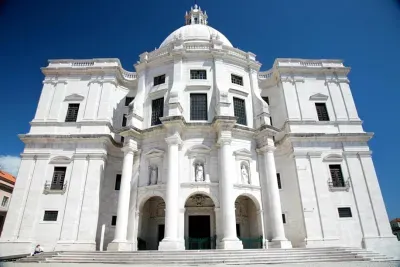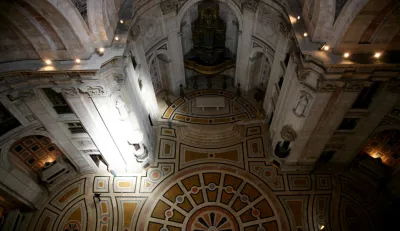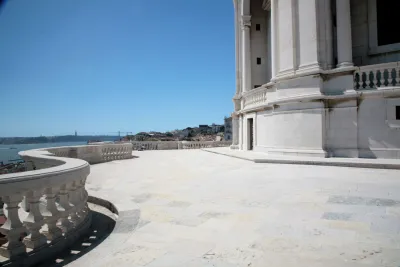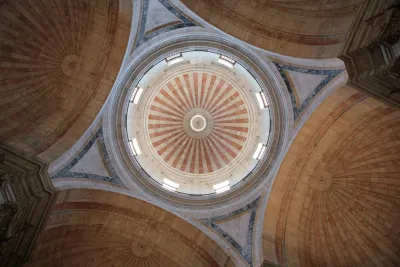
Santa Engracia - National Pantheon 
National Pantheon Interior 
Roof Terrace - National Pantheon 
National Pantheon ceilling The Church of Santa Engracia is one of Lisbon's finest religious buildings. Located close to the Monastery of São Vicente de Fora in the Alfama district, the white dome rises high above the surrounding jumble of cobbled streets.
The current building dates back to the 17th century although there had been previous churches on the site for around 100 years. As with the National Pantheon these churches were dedicated to Santa Engrácia, a 4th century martyr from Braga. Work began on the present day structure in 1681 after the previous had collapsed. The design was drafted by celebrated royal architect, João Antunes who was renowned for his Baroque styling. Unfortunately Antunes died in 1712 and King João V soon lost interest in the project; as a result construction stopped.
It wasn't until the 20th century that work started on Santa Engrácia once again. This hiatus in construction led to the term "Obras de Santa Engrácia" (meaning Santa Engrácia works) becoming a Portuguese euphemism for unfinished work.
Finally the church was finished in 1966 with the dome envisaged by Atunes being added. Its design is a Baroque style with the main entrance featuring two angels holding Portugal's coat of arms, while inside it is adorned with multicoloured marble on the walls and floor. There is public access to the roof where you can survey the dome and admire a 360 degree panoramic view of the Tagus River and the city skyline beyond.
Some time before its completion (1916) the church had been converted into the National Pantheon (Panteão Nacional), the burial place of a number of famous historical figures. One of the most notable and recent of these is Amalia Rodrigues, the legendary fado singer who hailed from the Alfama and died in 1999. Other dignitaries buried here include former presidents and authors such as Almeida Garrett. For some buried elsewhere there are cenotaphs; these include Vasco da Gama, Prince Henry the Navigator, Luís de Camões, Pedro Álvares Cabral and Afonso de Albuquerque.
Address
Campo de Santa ClaraAlfamaLisbon1100-471Phone
+351 21 885 4820
Alfama travel guide »
Occupying the tallest of Lisbon's hills, the district of Alfama brims with the feel of times gone by and is the truly emblematic part of the city. Largely spared in the earthquake of 1755, it is still a maze of narrow streets and steep steps, dimly lit taverns, flower-laden iron balconies and diminutive squares. Almost certainly the best way to see the wonders of this district, besides walking of…